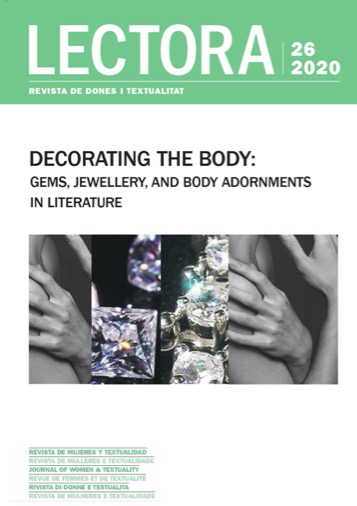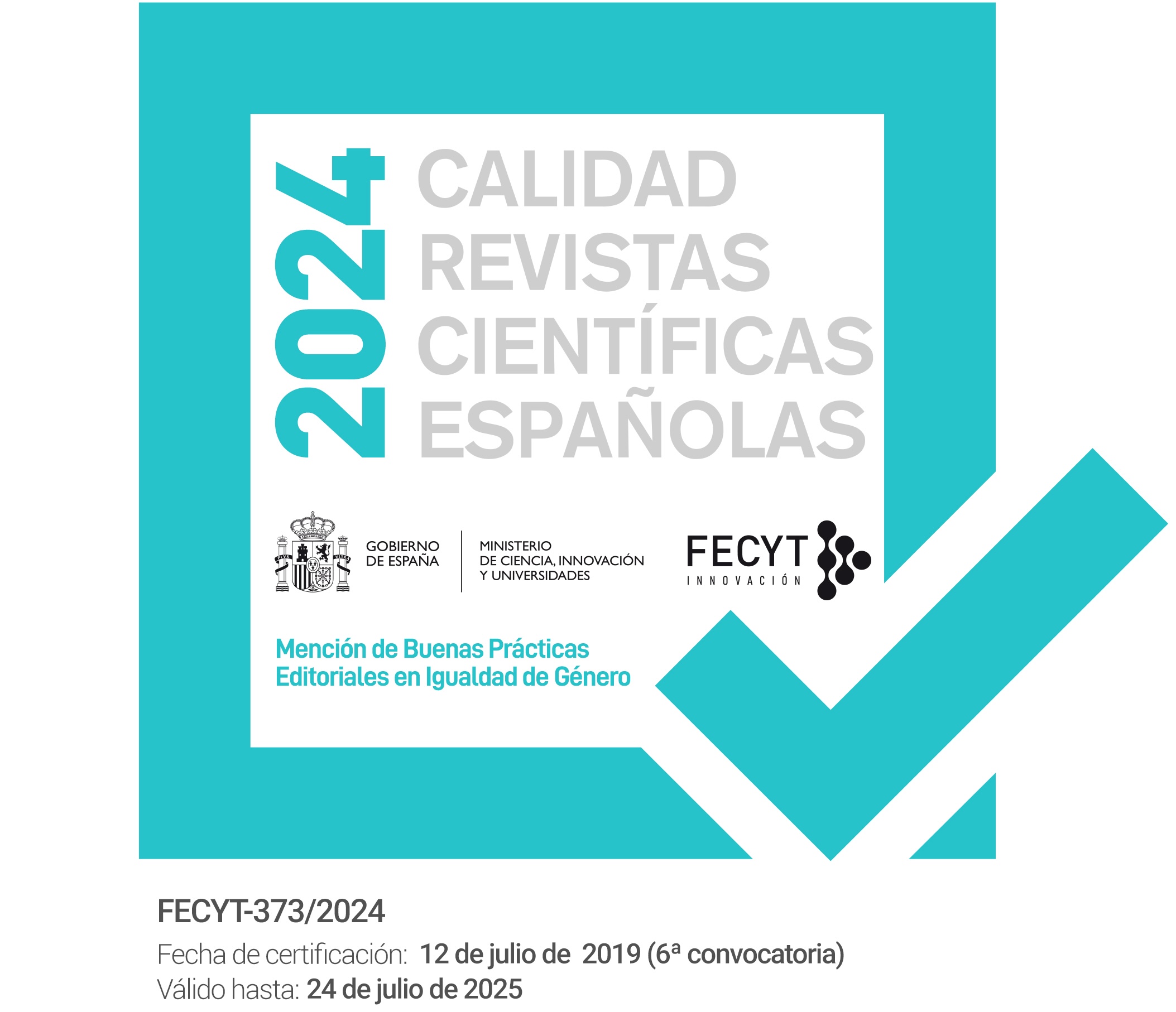Sensoriality and Hair Jewellery in Neo-Victorian Fiction and Culture
DOI:
https://doi.org/10.1344/Lectora2020.26.6Paraules clau:
hair jewellery, material culture, Victorian period, neo-VictorianismResum
In this essay I will focus on the role played by hair jewellery, a widespread craft in the nineteenth-century Anglo-American context, in neo-Victorian literature and culture. I will consider hair jewels as objects that are remnants of the Victorian past, but also as personal items that evoke affective responses through the senses. In this take on (neo-)Victorian literature and culture, I will consider the entanglement of subjects and objects, human remains (hair) and jewels, past and present, death and life in contemporary renditions of the Victorian craftwork of hair jewellery. Finally, I will argue that this fictionalisation of Victorian material traces allows us to mediate on the links and associations between the Victorian past and our (sensorial) responses to them, and that it opens up the ways to interrogate the affective relations between subjects and objects, the past and the present, then and now, as well as their impact upon our future.
Referències
Arnold, Jean (2011), Victorian Jewelry, Identity, and the Novel: Prisms of Culture, London & New York, Routledge.
Bachman, Maria K. (2016), "Dickens's Evocative Objects: A Tale of Two Lockets", Dickens Quarterly, 33 (1): 38-54.
Berry, Esther R. (2019), "Hurricane Katrina Hair: Rereading Nineteenth-Century Commemorative Hair Forms and Fragments Through the 'Mourning Portraits' of Loren Schwerd", Fashion Studies, 2 (1): 1-44.
Boehm, Katharina (2012), "Introduction: Bodies and Things", Bodies and Things in Nineteenth-Century Literature and Culture, Katharina Boehm (ed.), Basingstoke, Palgrave Macmillan: 1-16.
Brontë, Charlotte (1993), Villette, Sandra Kemp (ed.), London, Everyman. [1853]
Brontë, Emily (1995), Wuthering Heights, Pauline Nestor (ed.), Harmondworth, Penguin. [1847]
Brown, Bill (2001), "Thing Theory", Critical Inquiry, 28 (1): 1-22.
—(2003), A Sense of Things: The Object Matter of American Literature, Chicago, University of Chicago Press.
Browne, Victoria (2014), Feminism, Time, and Nonlinear History, Basingstoke, Palgrave Macmillan.
Chidgey, Catherine (2005), The Transformation: A Novel, New York, Picador.
Cohen, William A. (2009), Embodied: Victorian Literature and the Senses, Minneapolis & London, University of Minnesota Press.
Collins, Wilkie (1992), The Moonstone, Catherine Peters (ed.), New York & London, Alfred A. Knopf.
Cox, Jessica (2017), "Neo-Victorianism", Oxford Bibliographies. DOI: 10.1093/OBO/9780199799558-0083.
Department for Culture, Media and Sport (DCMS) (2005), Guidance for the Care of Human Remains in Museums, London, DCMS.
Dickens, Charles (1996), Oliver Twist, Salt Lake City, Project Gutenberg. <http://www.gutenberg.org/ebooks/730> [1838]
Fox, Essie (2013), The Goddess and the Thief, London, Orion.
Gamble, Sarah (2009), "'You Cannot Impersonate What You Are': Questions of Authenticity in the Neo-Victorian Novel", LIT: Literature, Interpretation, Theory, 20 (1-2): 126-40.
Gilbert, Pamela K. (2019), Victorian Skin: Surface, Self, History, Ithaca & London, Cornell UP.
Hamilakis, Yannis (2013), Archaeology of the Senses: Human Experience, Memory, and Affect, Cambridge, Cambridge UP.
Hardy, Thomas (1993), Far from the Madding Crowd, Ware, Wordsworth.
Heilmann, Ann, and Mark Llewellyn (2010), Neo-Victorianism: The Victorians in the Twenty-First Century, 1999-2009, Basingstoke, Palgrave Macmillan.
Hodder, Ian (2012), Entangled: An Archaeology of the Relationships between Humans and Things, Chichester, Wiley-Blackwell.
Jordan, Justine (2005), "Cutting Edge", Review of Catherine Chidgey's The Transformation, The Guardian, 09/04/05. <https://www.theguardian.com /books/2005/apr/09/featuresreviews.guardianreview8>
Lutz, Deborah (2015a), The Brontë Cabinet: Three Lives in Nine Objects, London & New York, W. W. Norton.
—(2015b), Relics of Death in Victorian Literature and Culture, Cambridge, Cambridge UP.
Maxwell, Catherine (2017), Scents and Sensibility: Perfume in Victorian Literary Culture, Oxford, Oxford UP.
Newton, Grace (2019), "£25 Antiques Roadshow ring found to contain lock of Charlotte Brontë's hair", Yorkshire Post, 22/11/2020. <https://www.yorkshire post.co.uk/heritage-and-retro/heritage/ps25-antiques-roadshow-ring-found- contain-lock-charlotte-brontes-hair-1756508>
Ofek, Galia (2009), Representations of Hair in Victorian Literature and Culture, Farnham, Ashgate Publishing.
Parkins, Wendy (2009), "Trust your Senses?: An Introduction to the Victorian Sensorium", Australasian Journal of Victorian Studies, 14 (2): 1-7.
Pointon, Marcia (1999), "Materializing Mourning: Hair, Jewellery and the Body", Material Memories: Design and Evocation, Marius Kwint, Christopher Breward, and Jeremy Aynsley (eds.), Oxford and New York, Berg: 39-57.
Purcell, Laura (2019), Bone China, London, Raven Books.
Ricoeur, Paul (1985), Time and Narrative Volume 3, Kathleen Blamey and David Pellauer (trans.), Chicago & London, University of Chicago Press.
Sattaur, Jennifer (2012), "Thinking Objectively: An Overview of 'Thing Theory' in Victorian Studies", Victorian Literature and Culture, 40: 347-57.
Tarlo, Emma (2016), Entanglement: The Secret Lives of Hair, London, Oneworld.
Thomas, Julian (2006), "Phenomenology and Material Culture", Handbook of Material Culture. Chris Tilley, Webb Keane, Susanne Kueschler, Mike Rowlands, and Patricia Spyer (eds.), London, SAGE: 42-59.
Wildgoose, Jane (2019), "Beyond All Price: Victorian Hair Jewelry, Commemoration & Story-Telling", Fashion Theory: The Journal of Dress, Body and Culture, 22 (6): 699-726.
Yan, Shu-chuan (2019), "The Art of Working in Hair: Hair Jewellery and Ornamental Handiwork in Victorian Britain", The Journal of Modern Craft, 12 (2): 123-139.
Descàrregues
Publicades
Com citar
Número
Secció
Llicència
Els autors i les autores conserven els drets d’autoria i atorguen a Lectora: revista de dones i textualitat el dret de difusió. L'’obra serà disponible simultàniament sota una Llicència de Reconeixement-NoComercial- SenseObraDerivada de Creative Commons que, si no si indica el contari, permet compartir l’obra amb tercers, sempre que aquests en reconeguin l’autoria i la publicació inicial en aquesta revista.
Els autors i autores són lliures de fer acords contractuals addicionals independents per a la distribució no exclusiva de la versió de l’obra publicada a la revista (com ara la publicació en un repositori institucional o en un llibre), sempre que se’n reconegui la publicació inicial en aquesta revista.
S’encoratja els autors i autores a reproduir la seva obra en línia (en repositoris institucionals, temàtics o a la seva pàgina web, per exemple), amb l’objectiu d’aconseguir intercanvis productius i fer que l’obra obtingui més citacions (vegeu The Effect of Open Access, en anglès).




